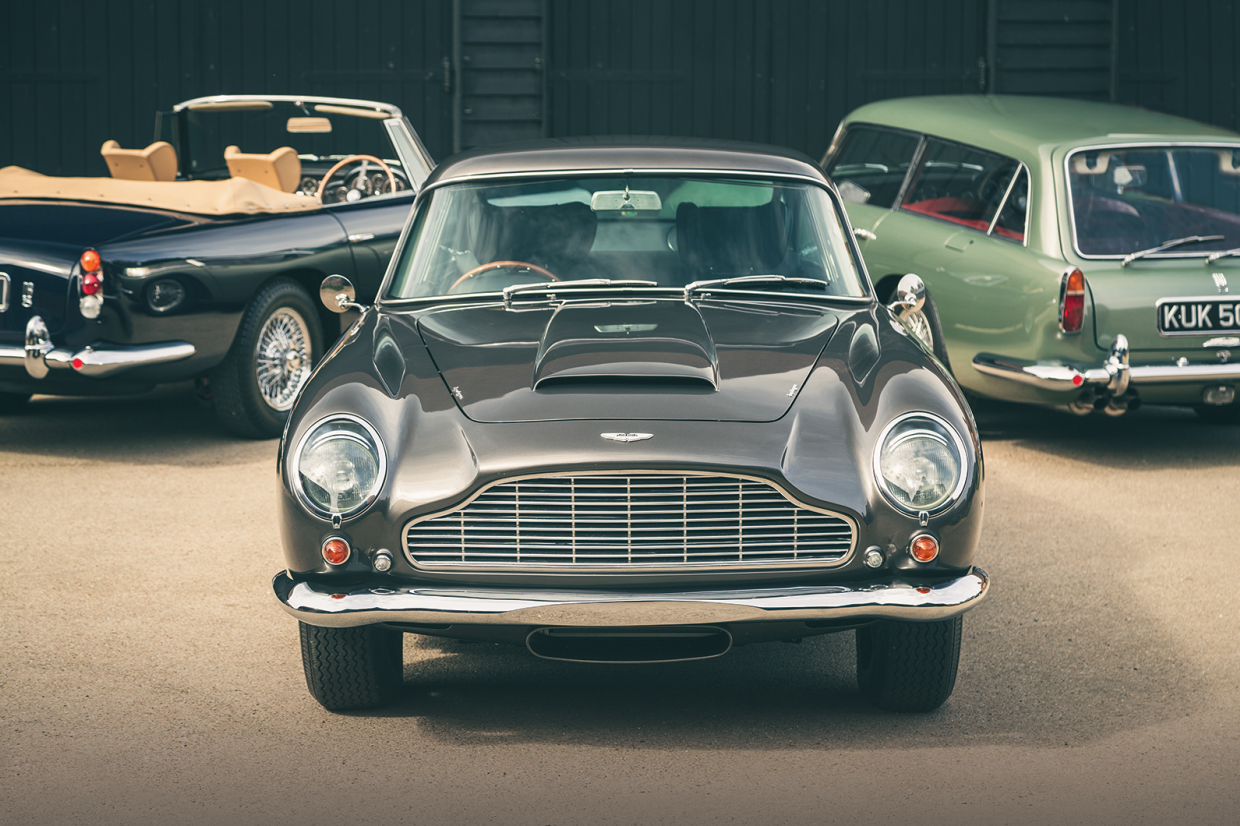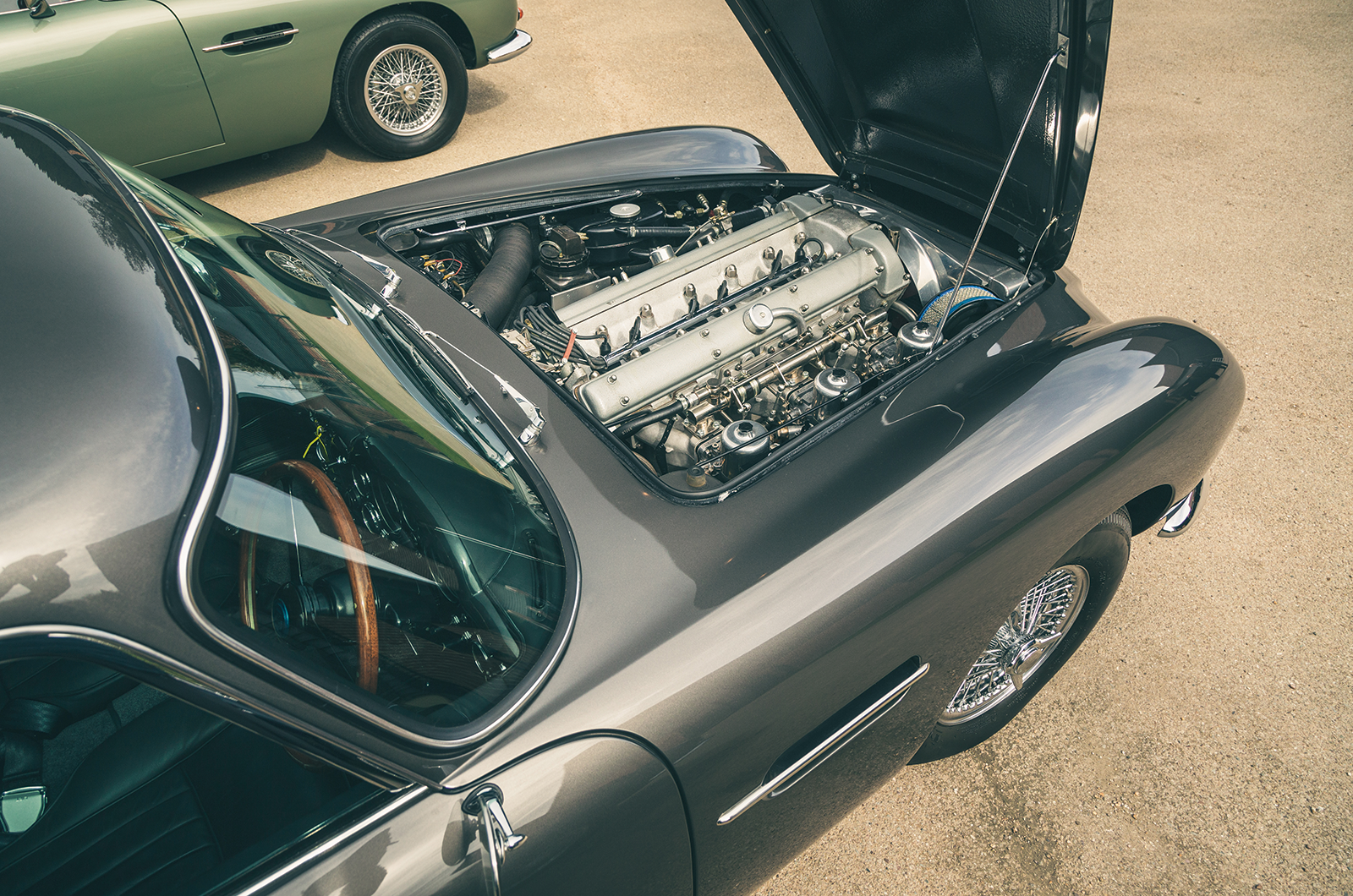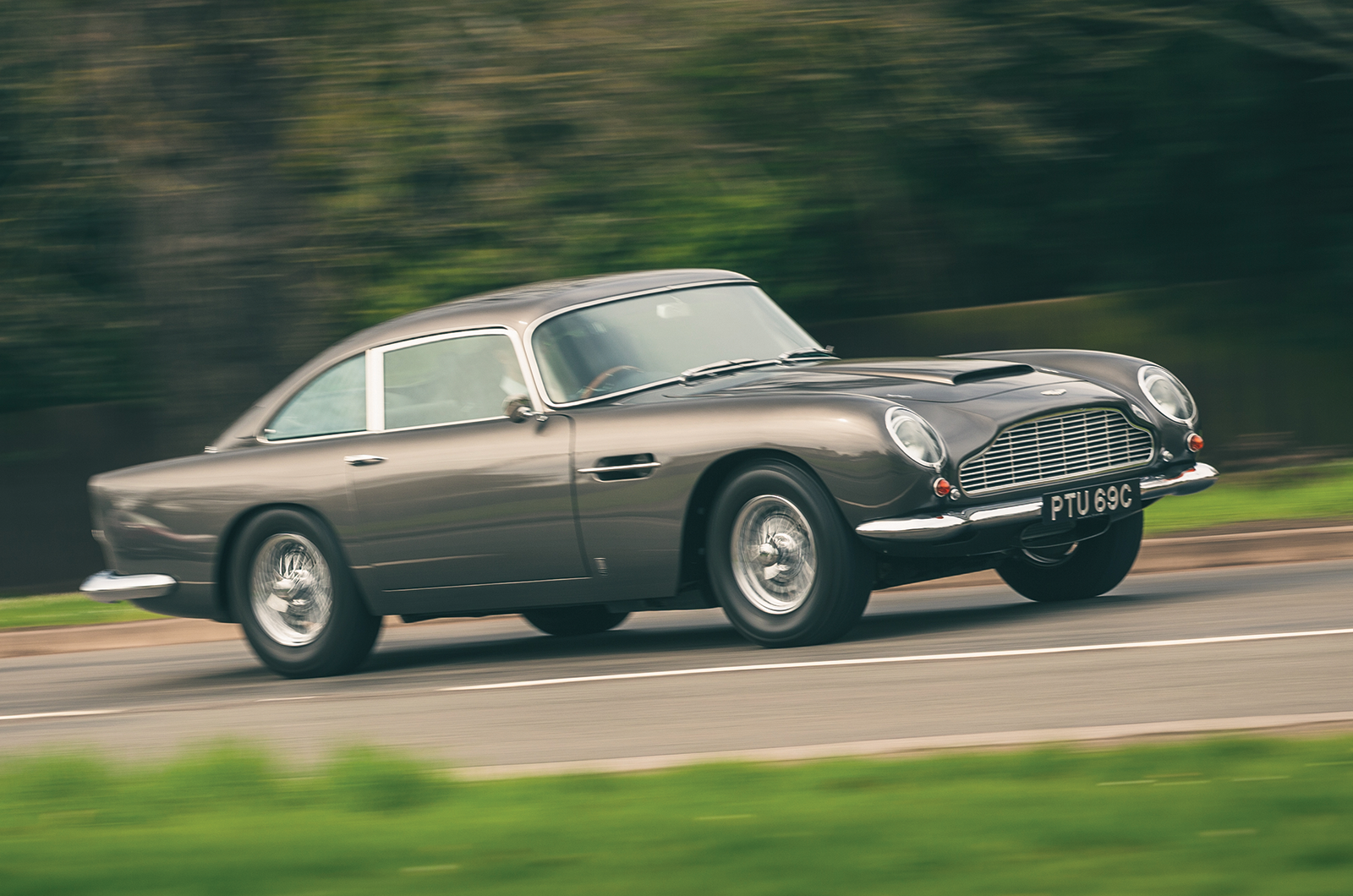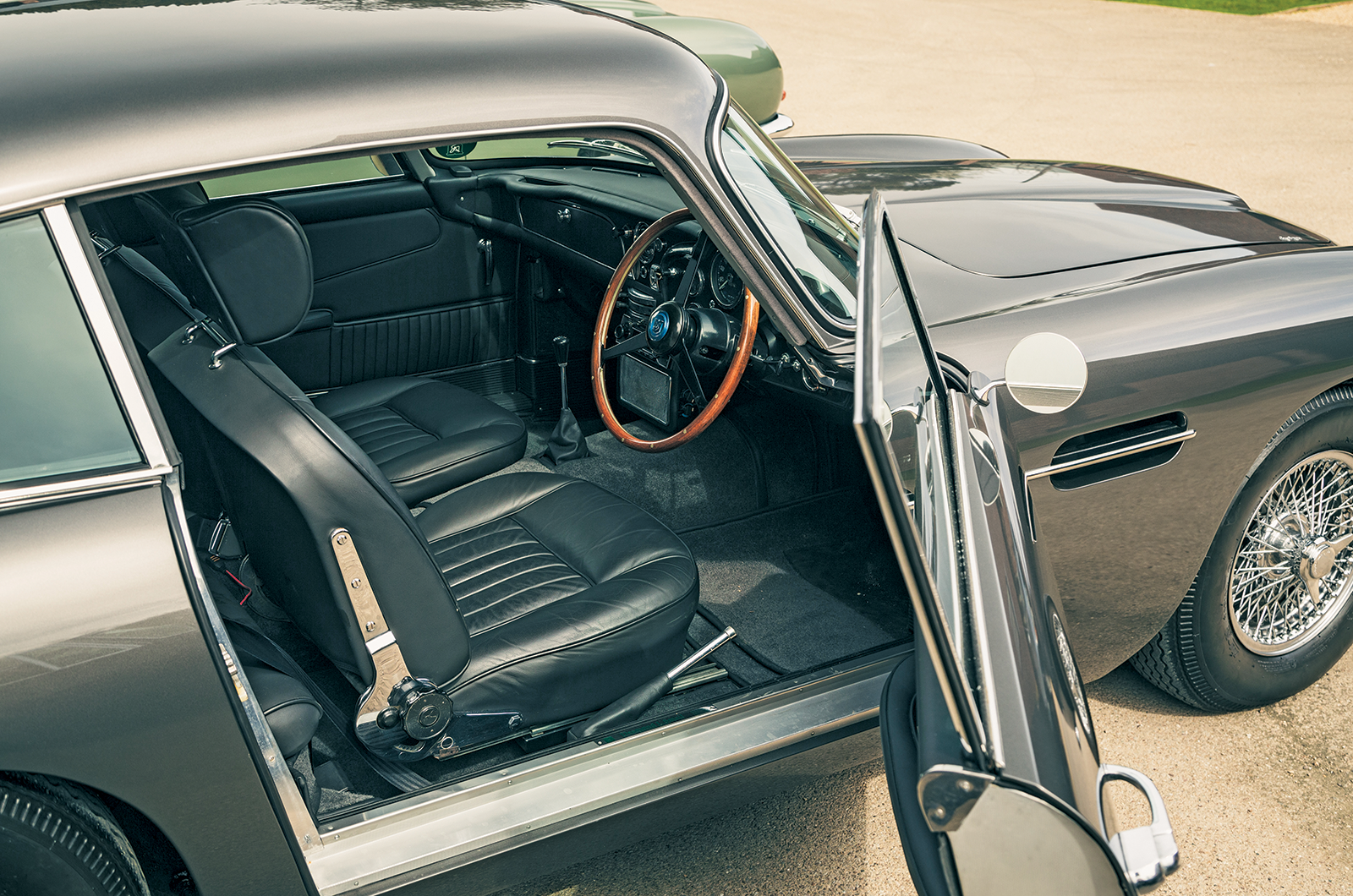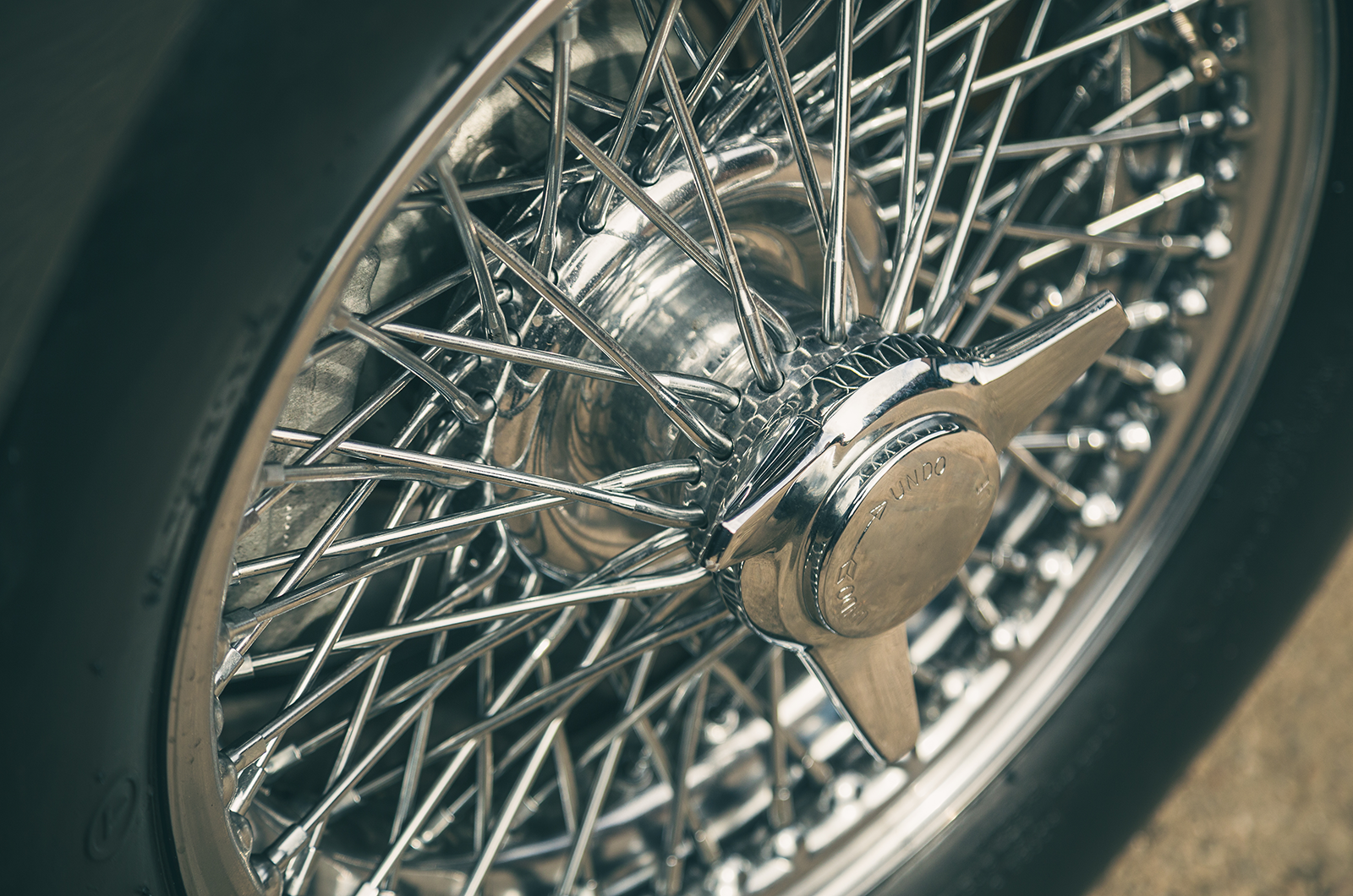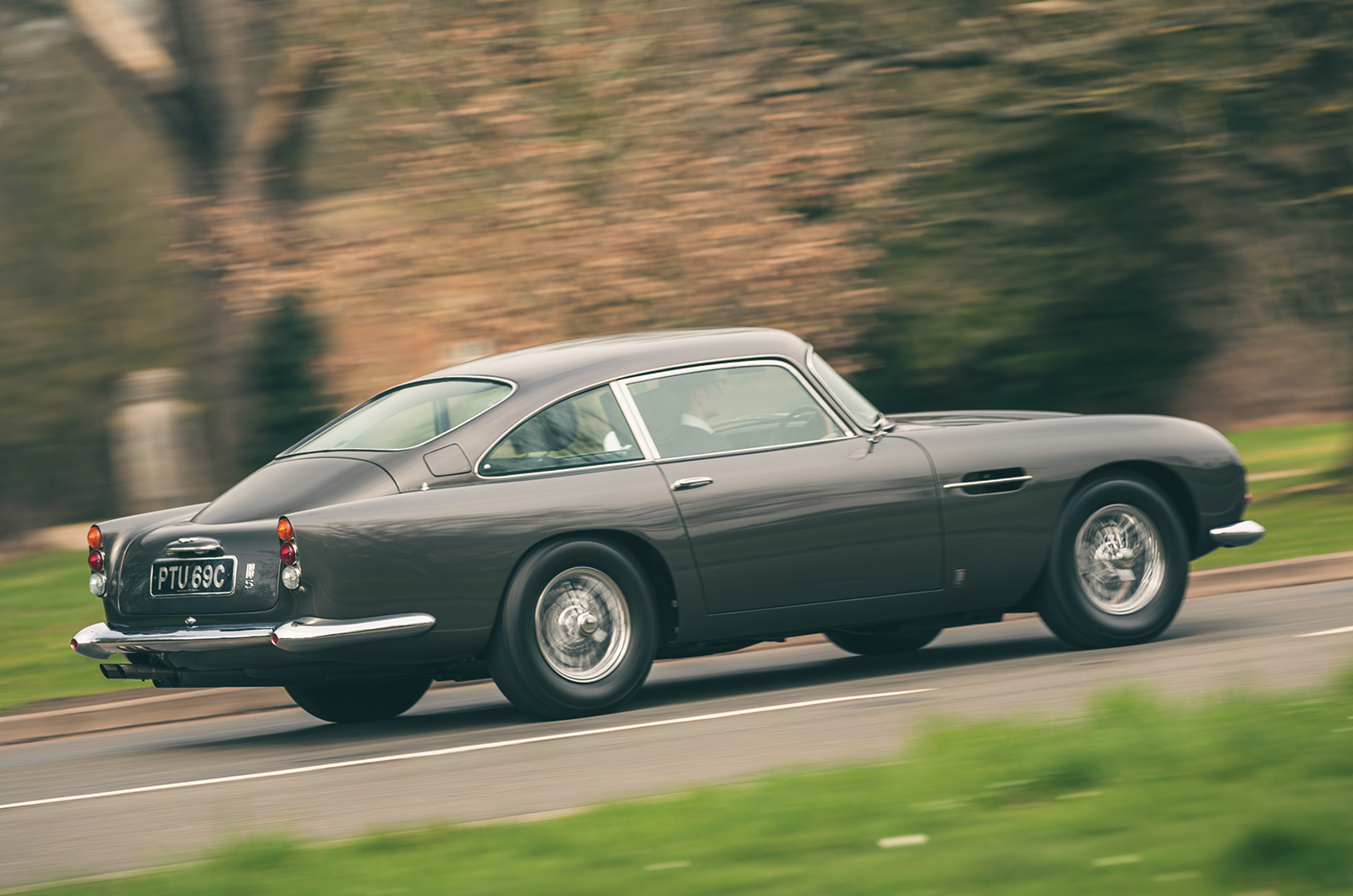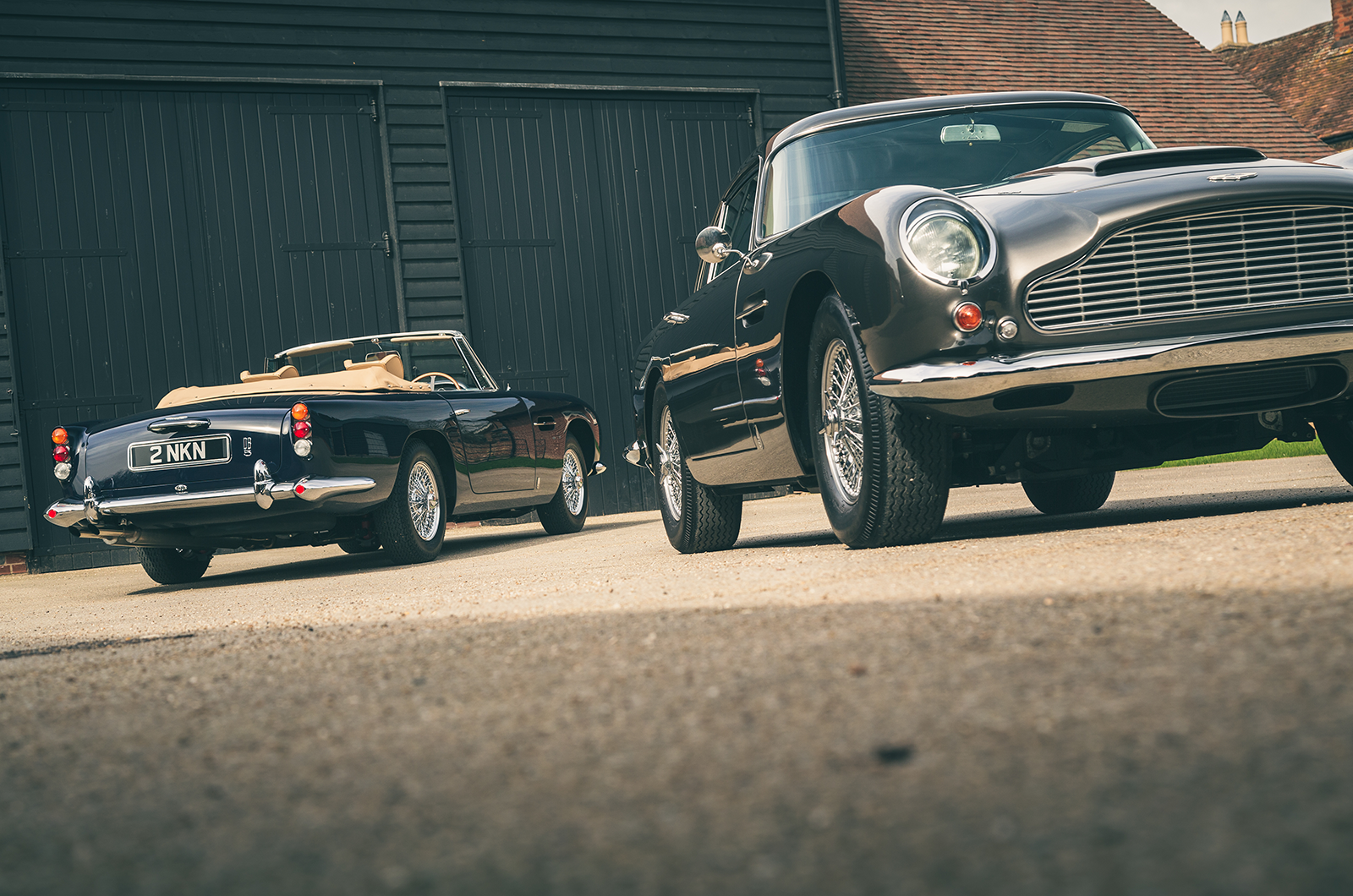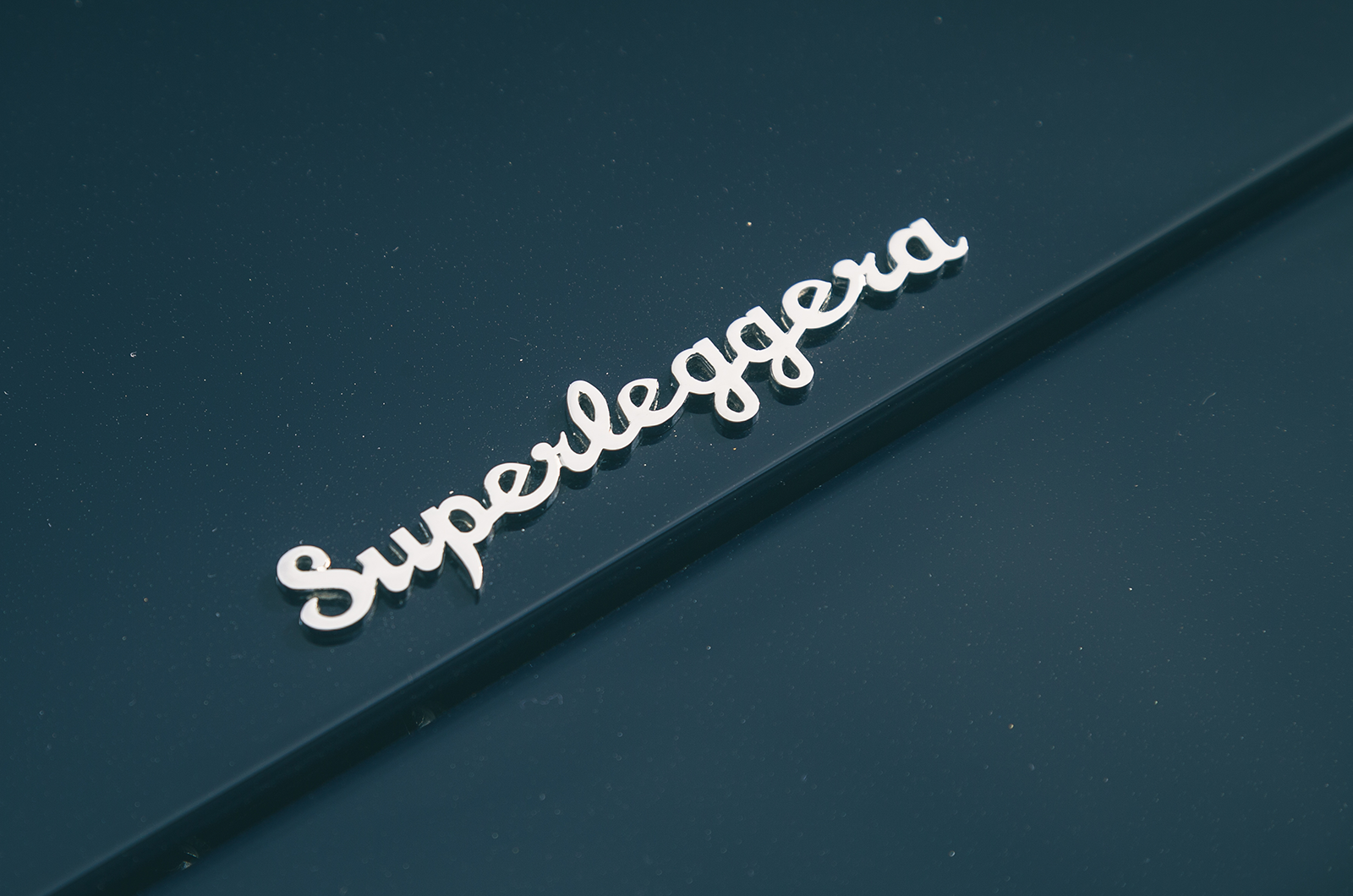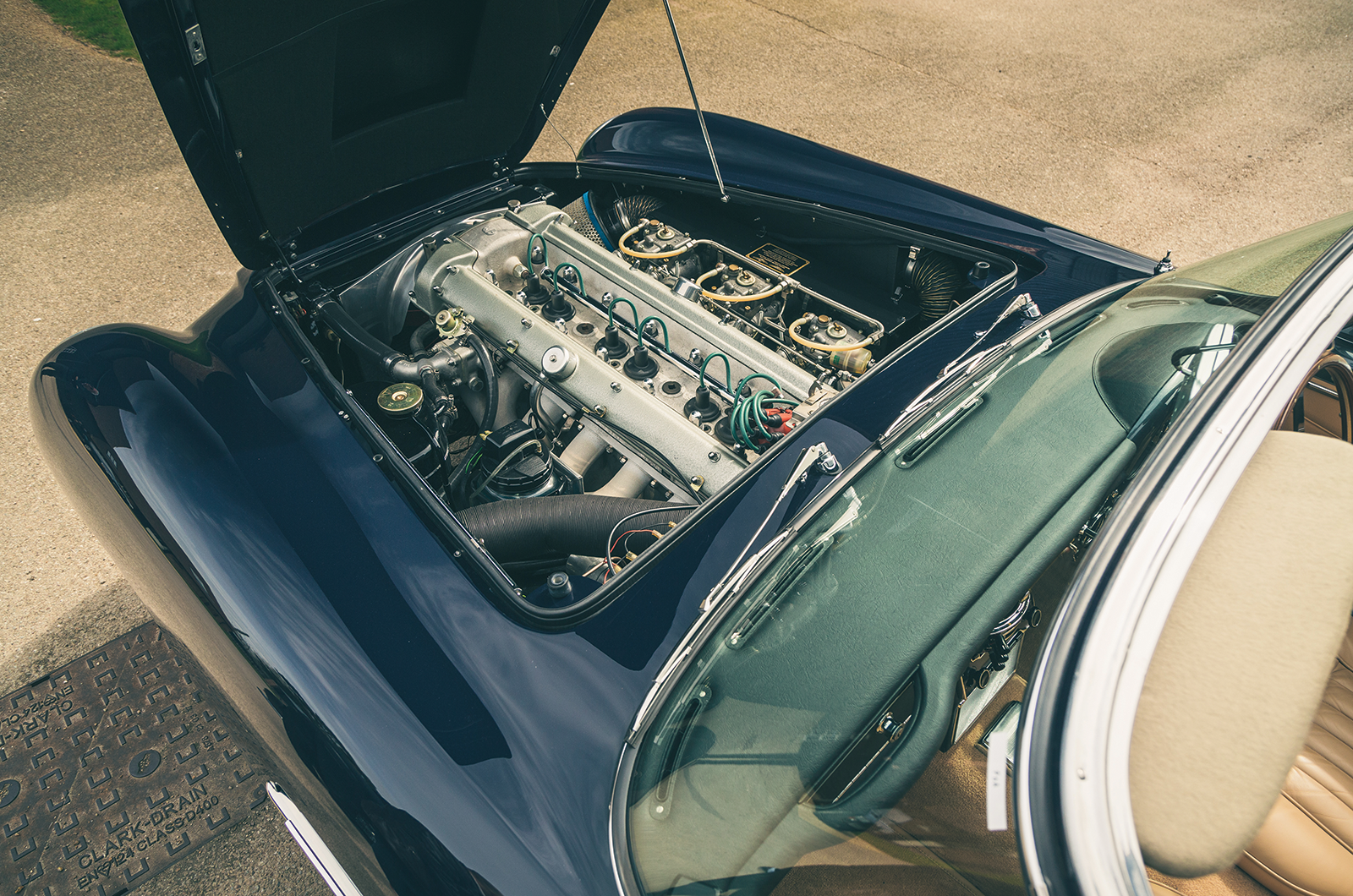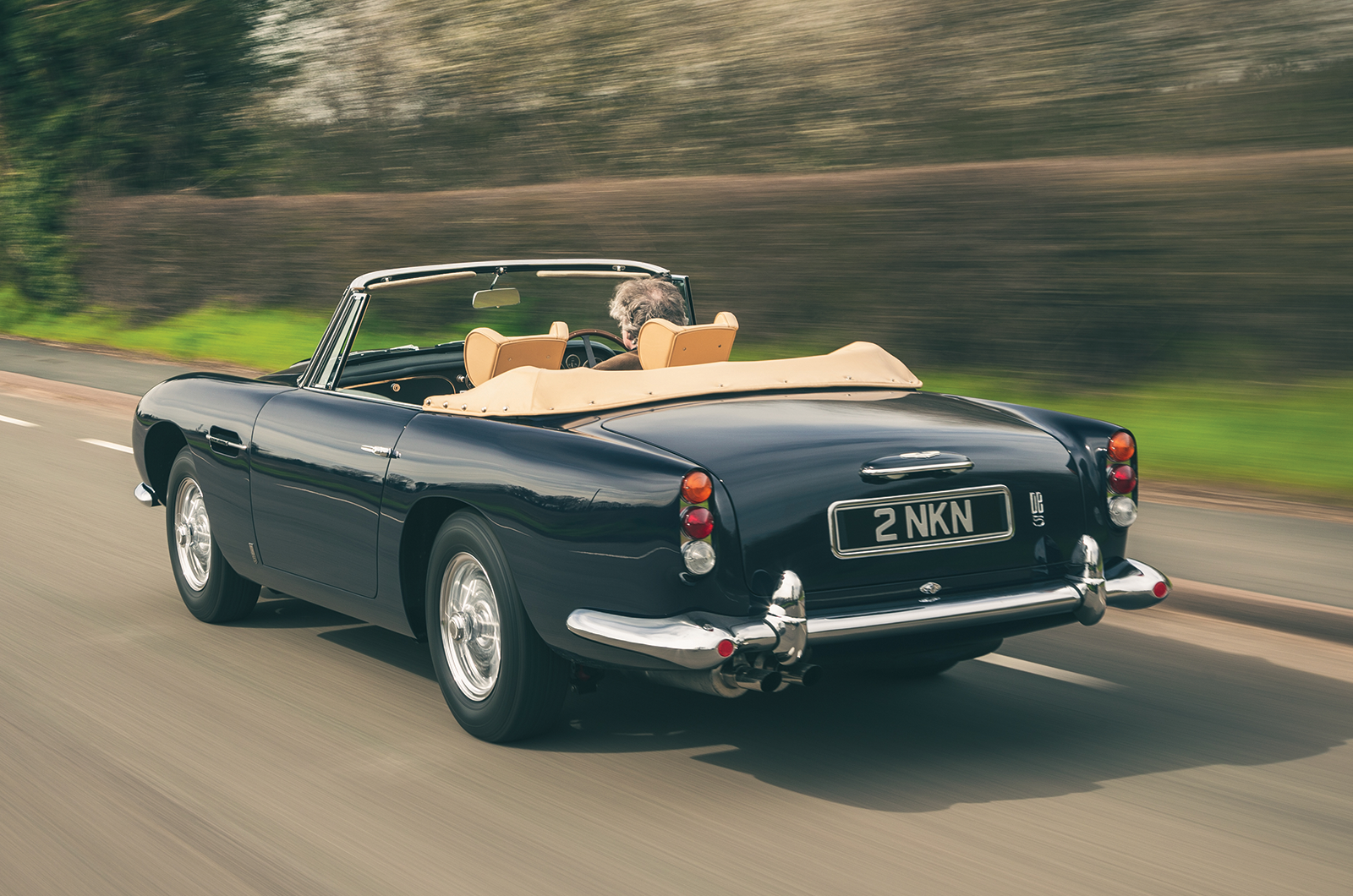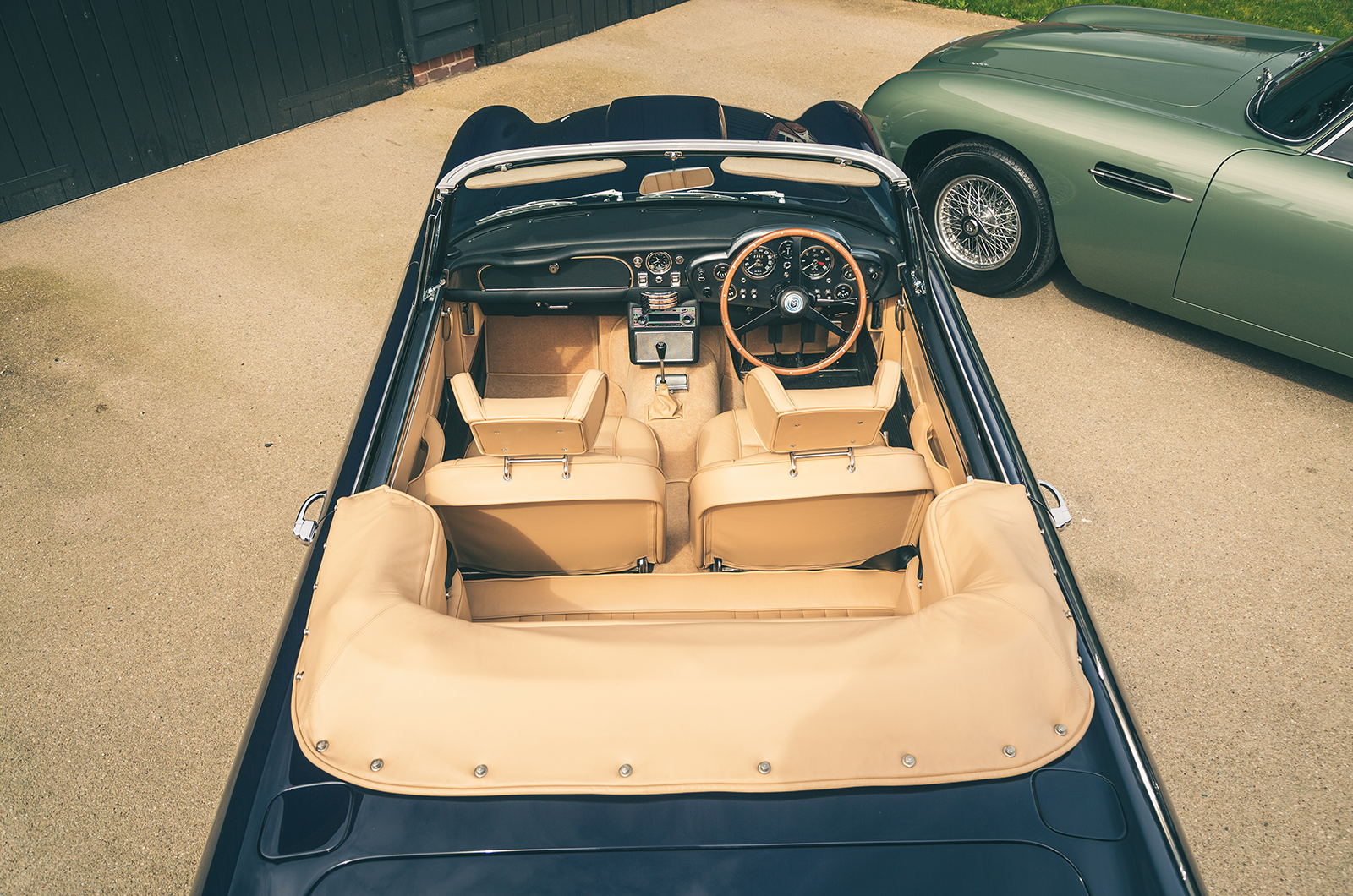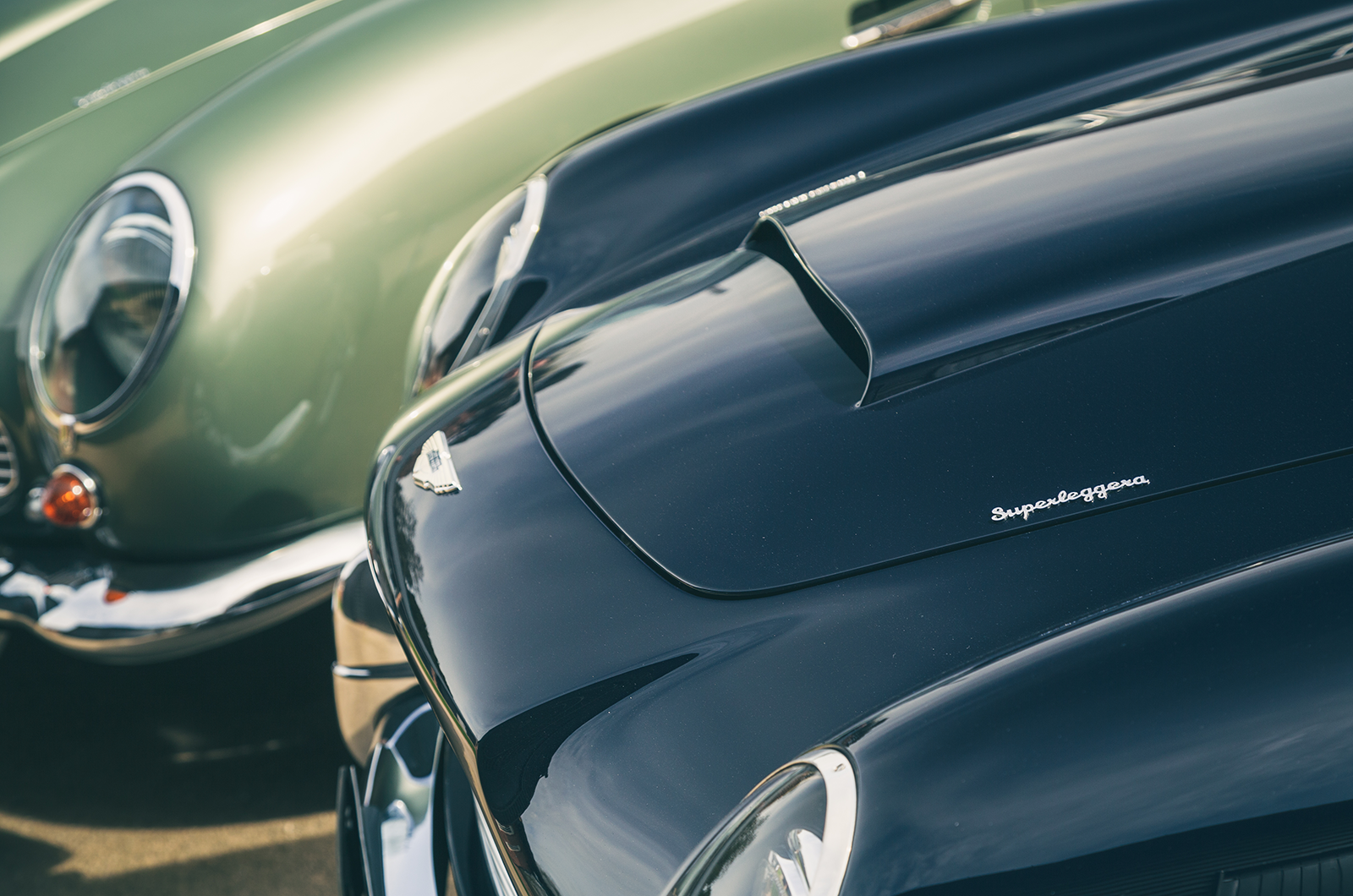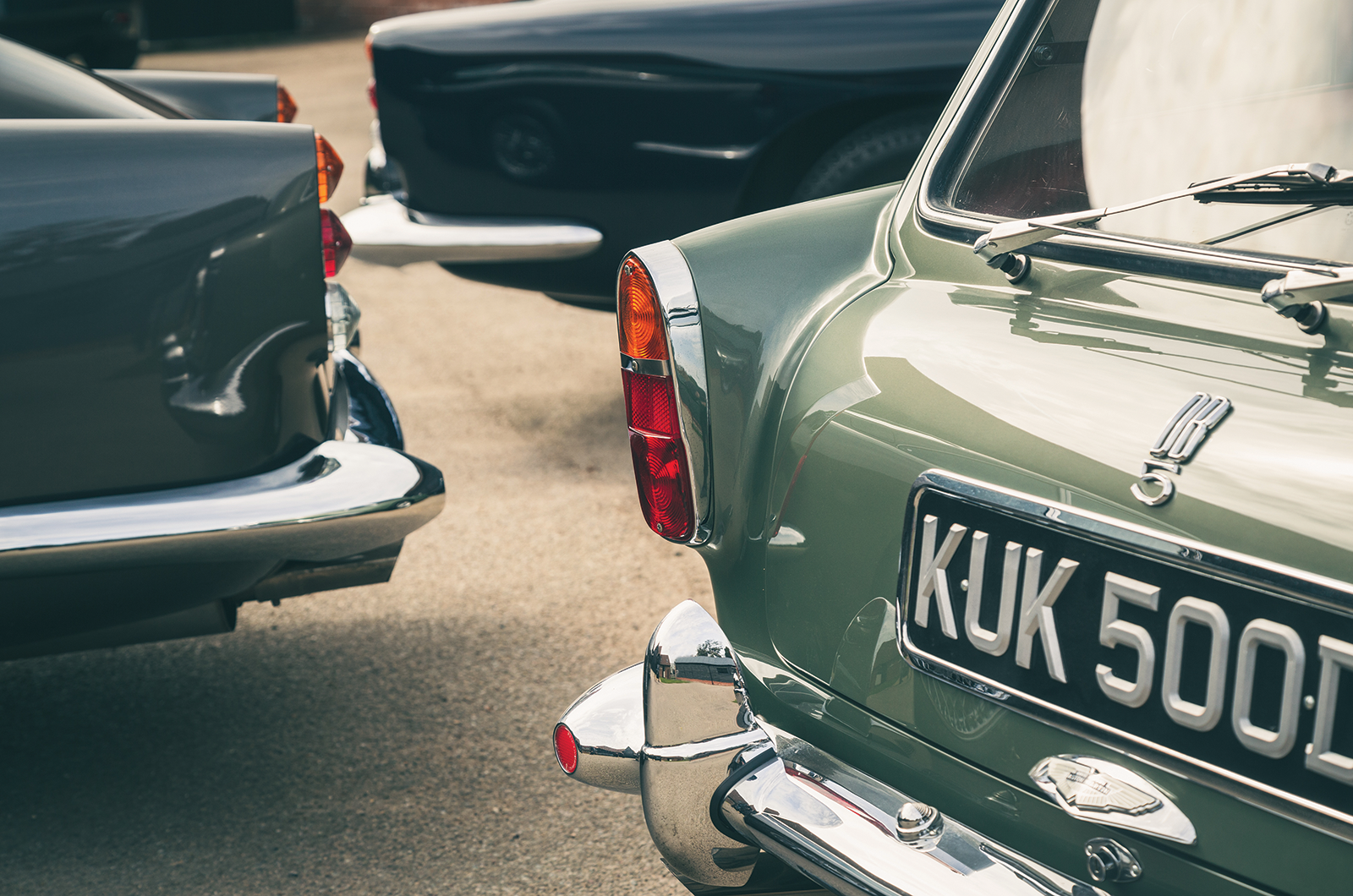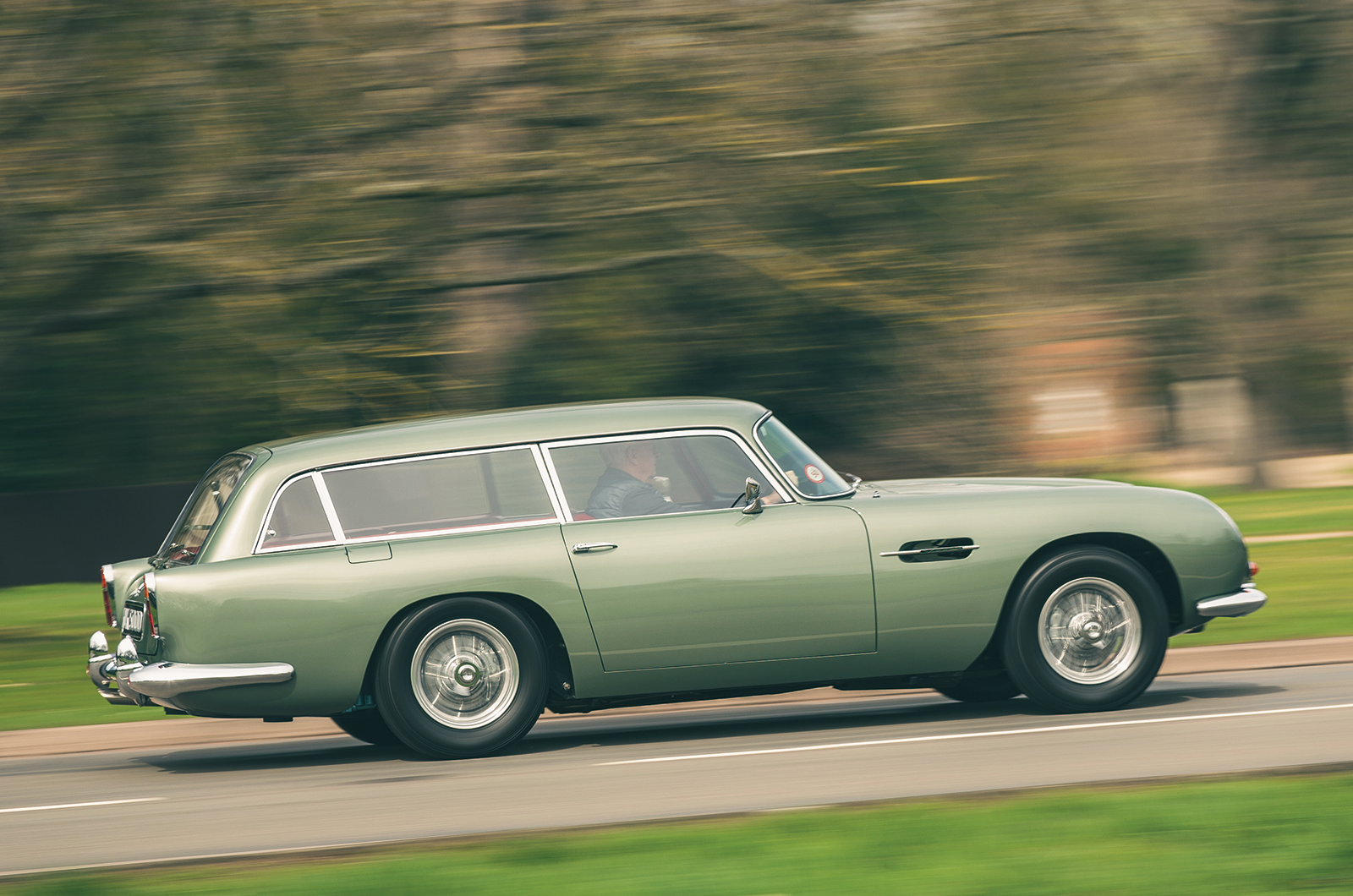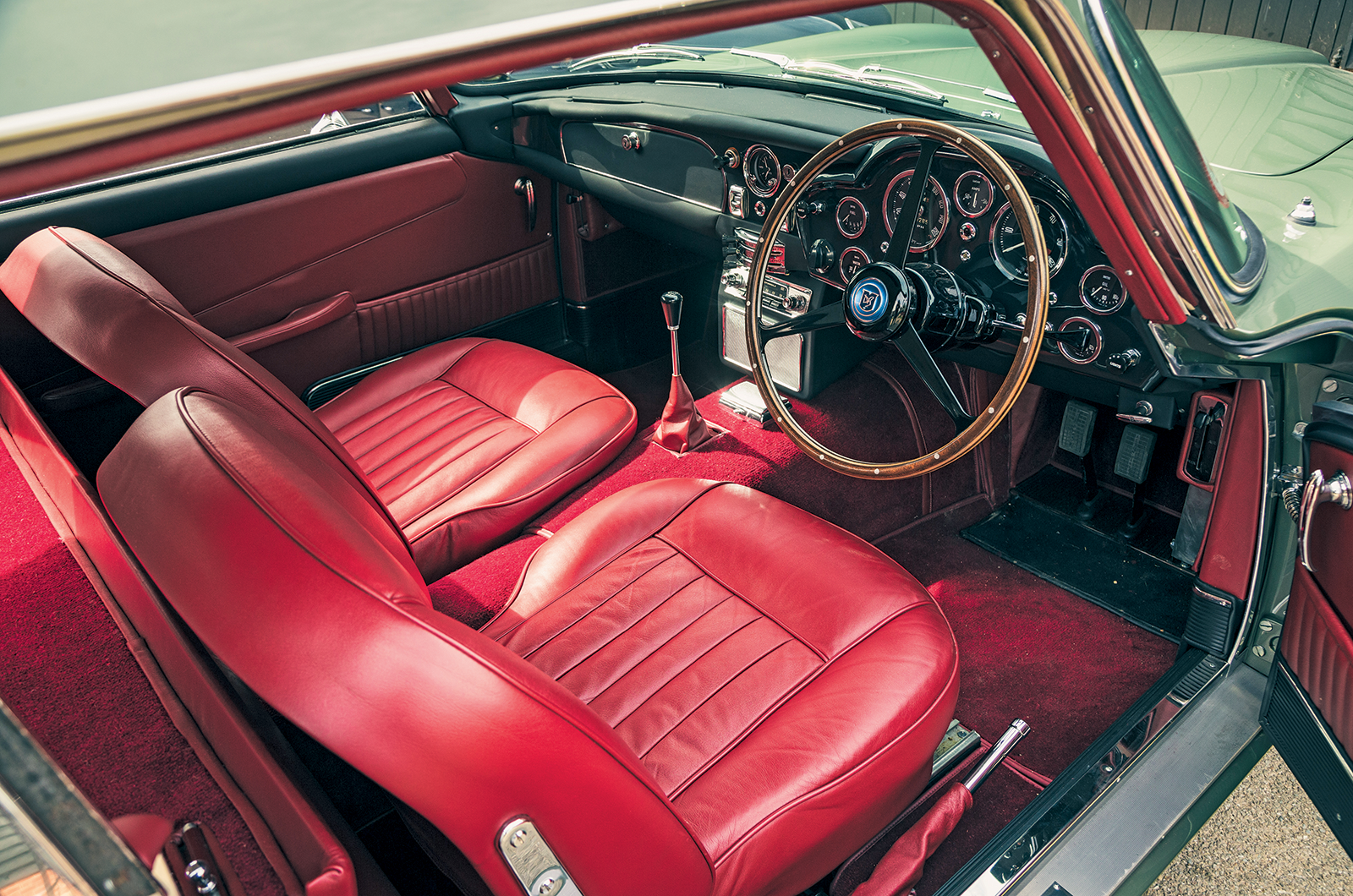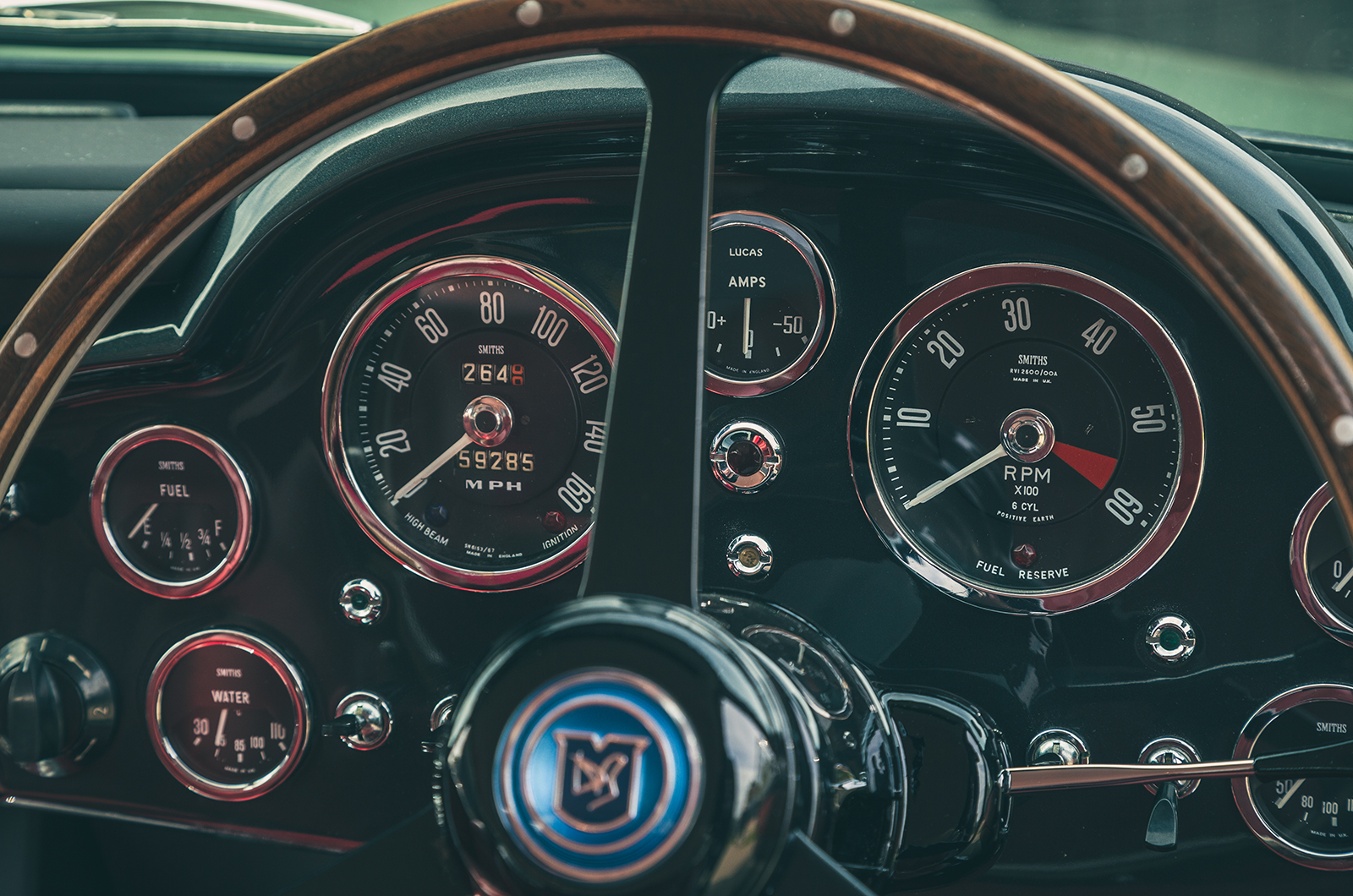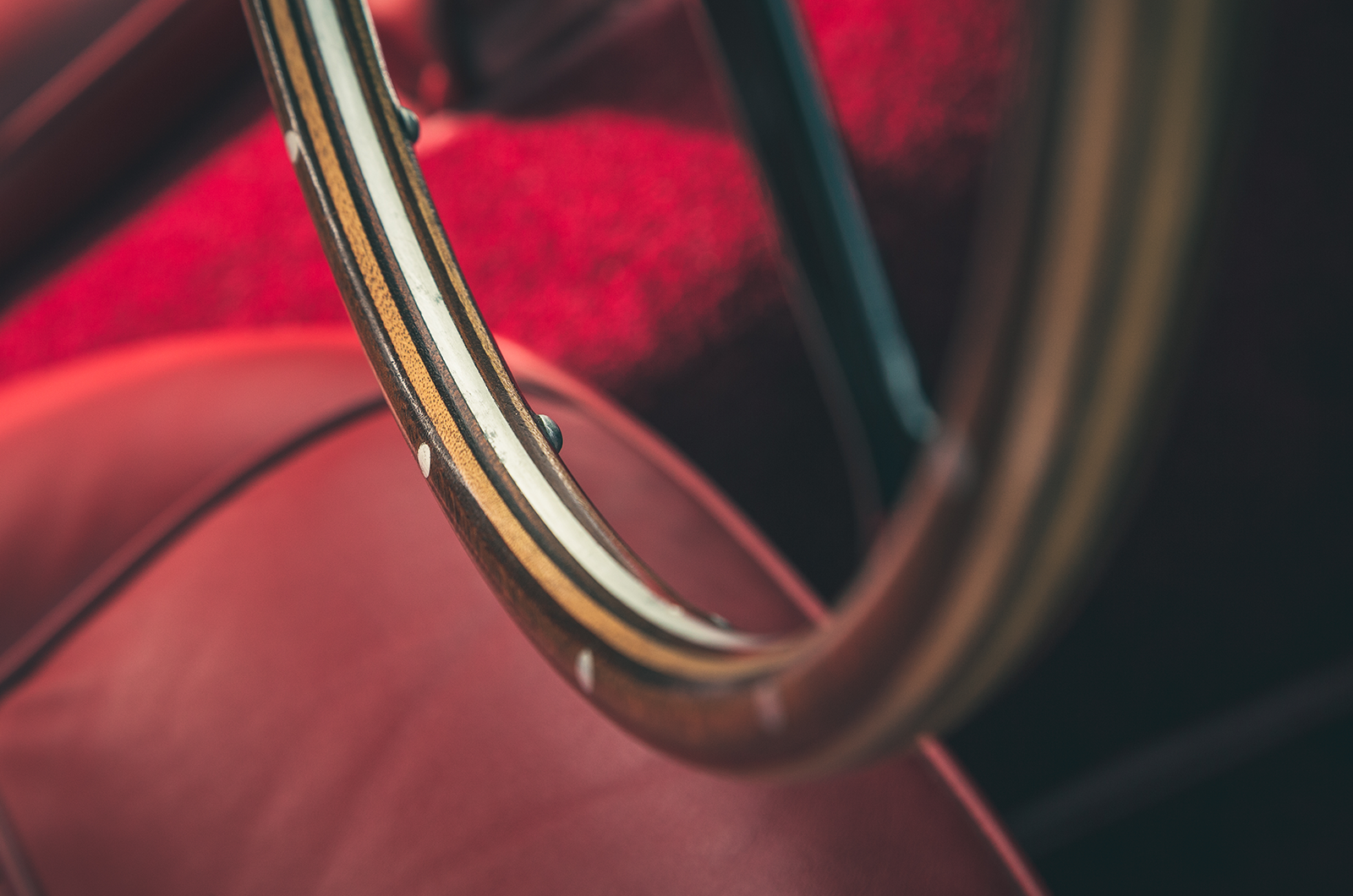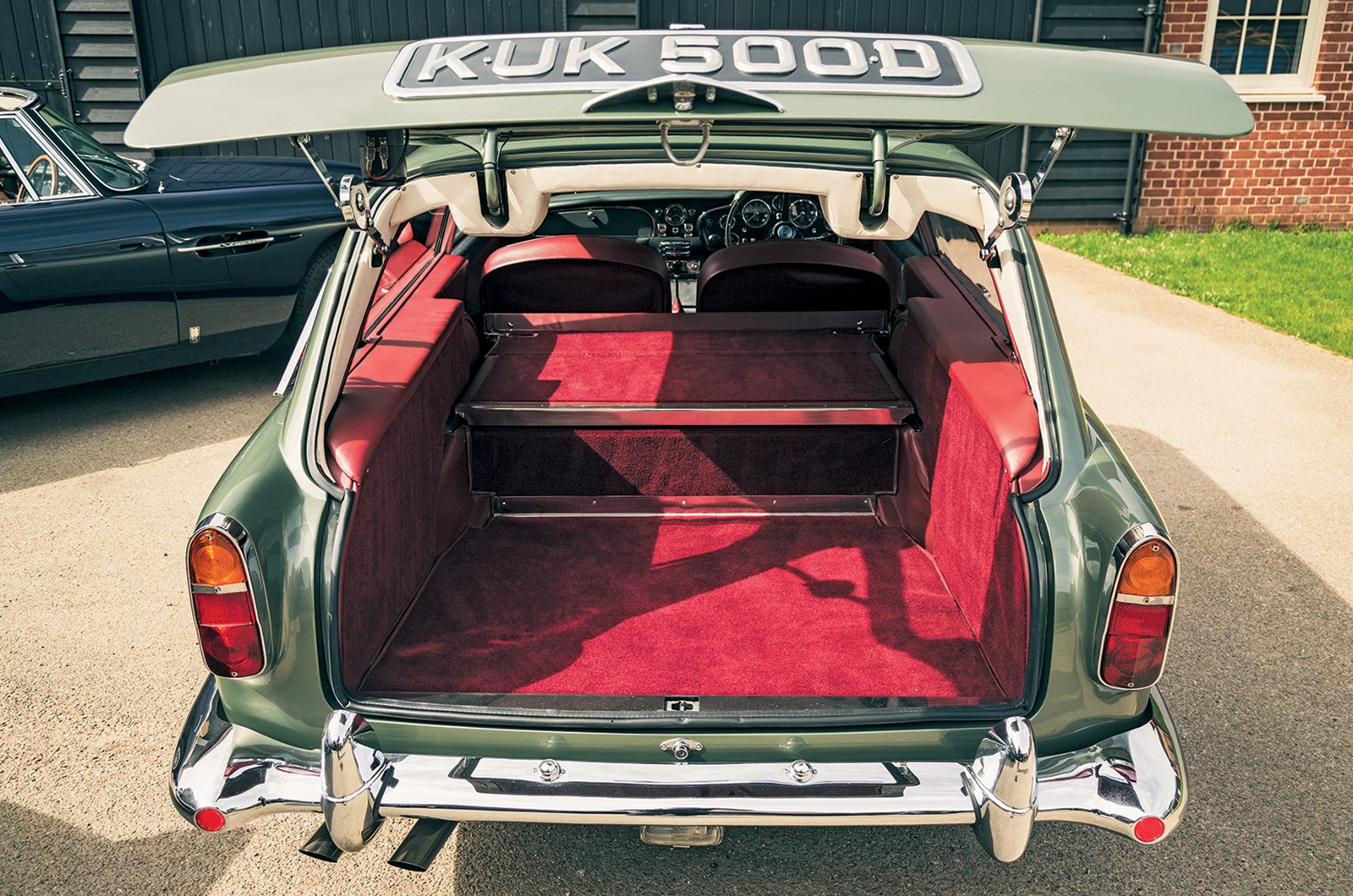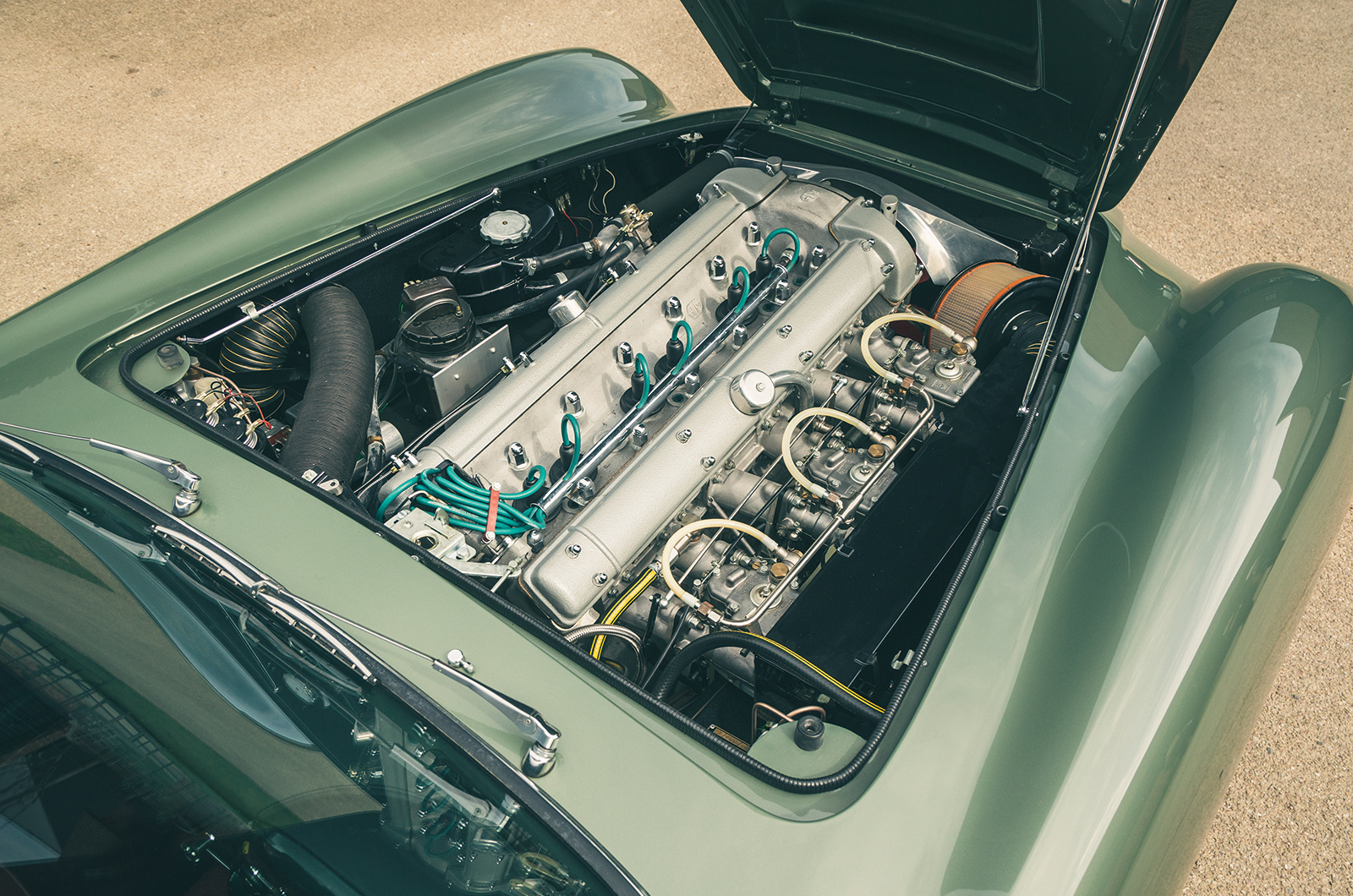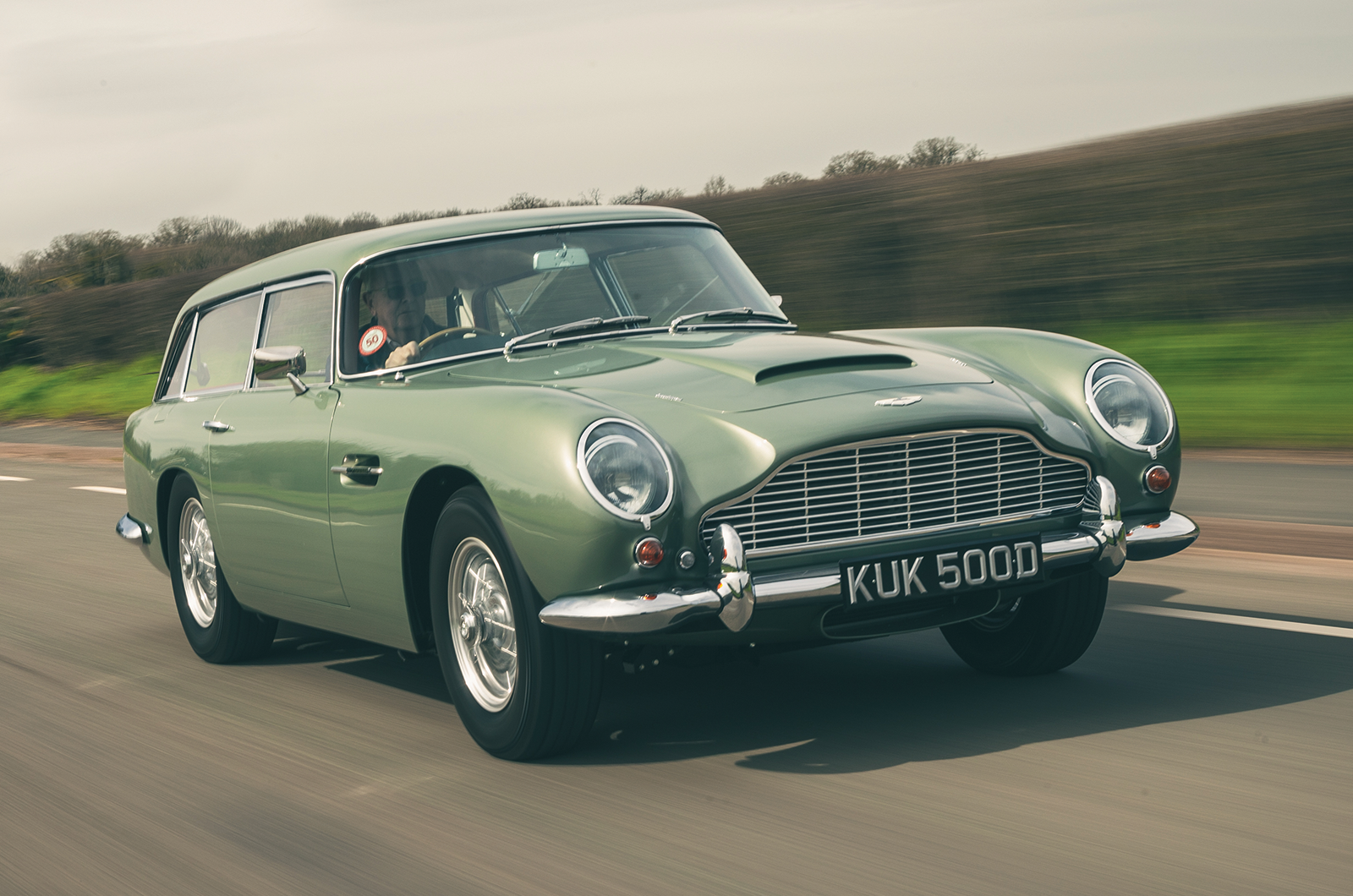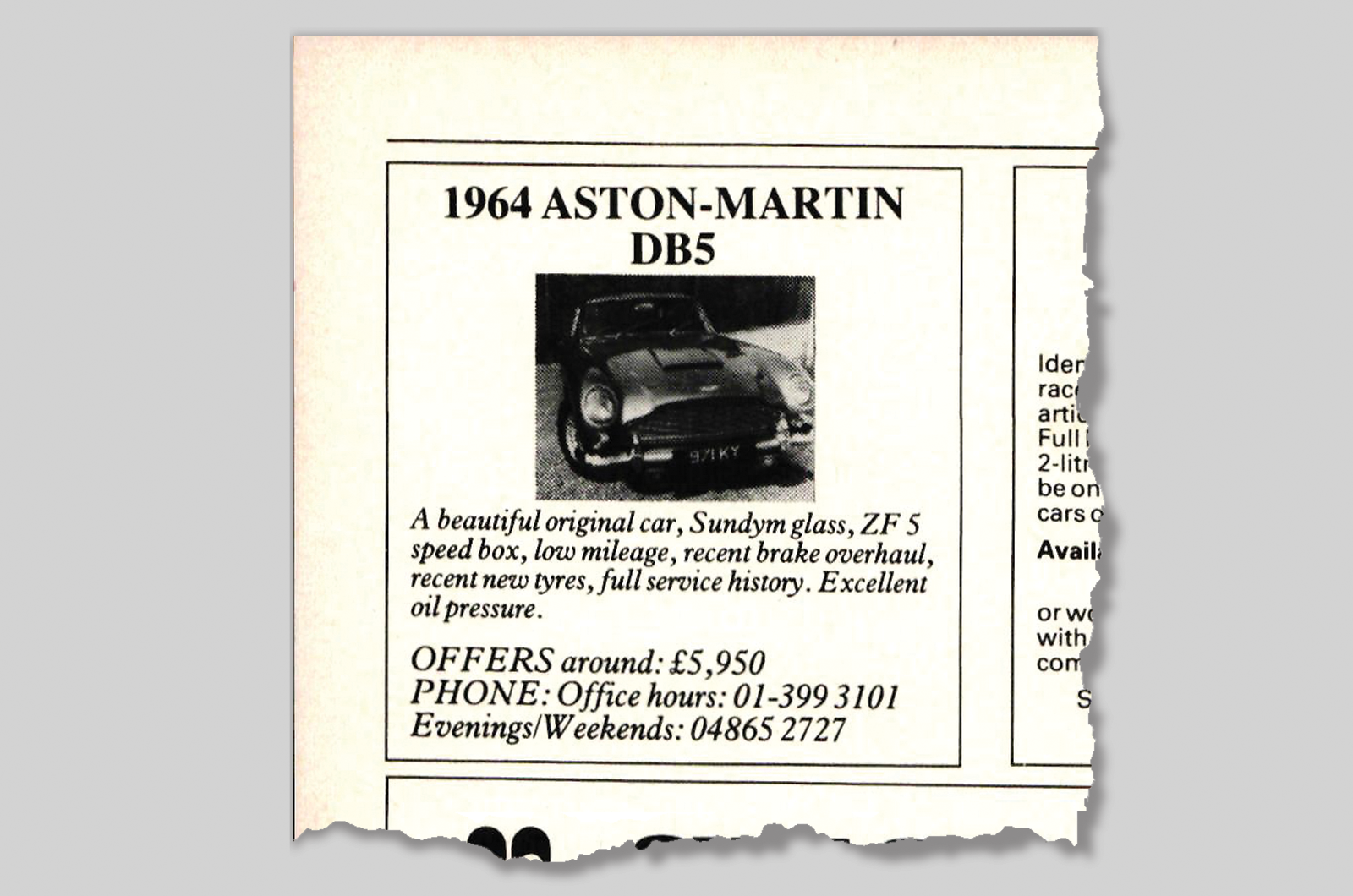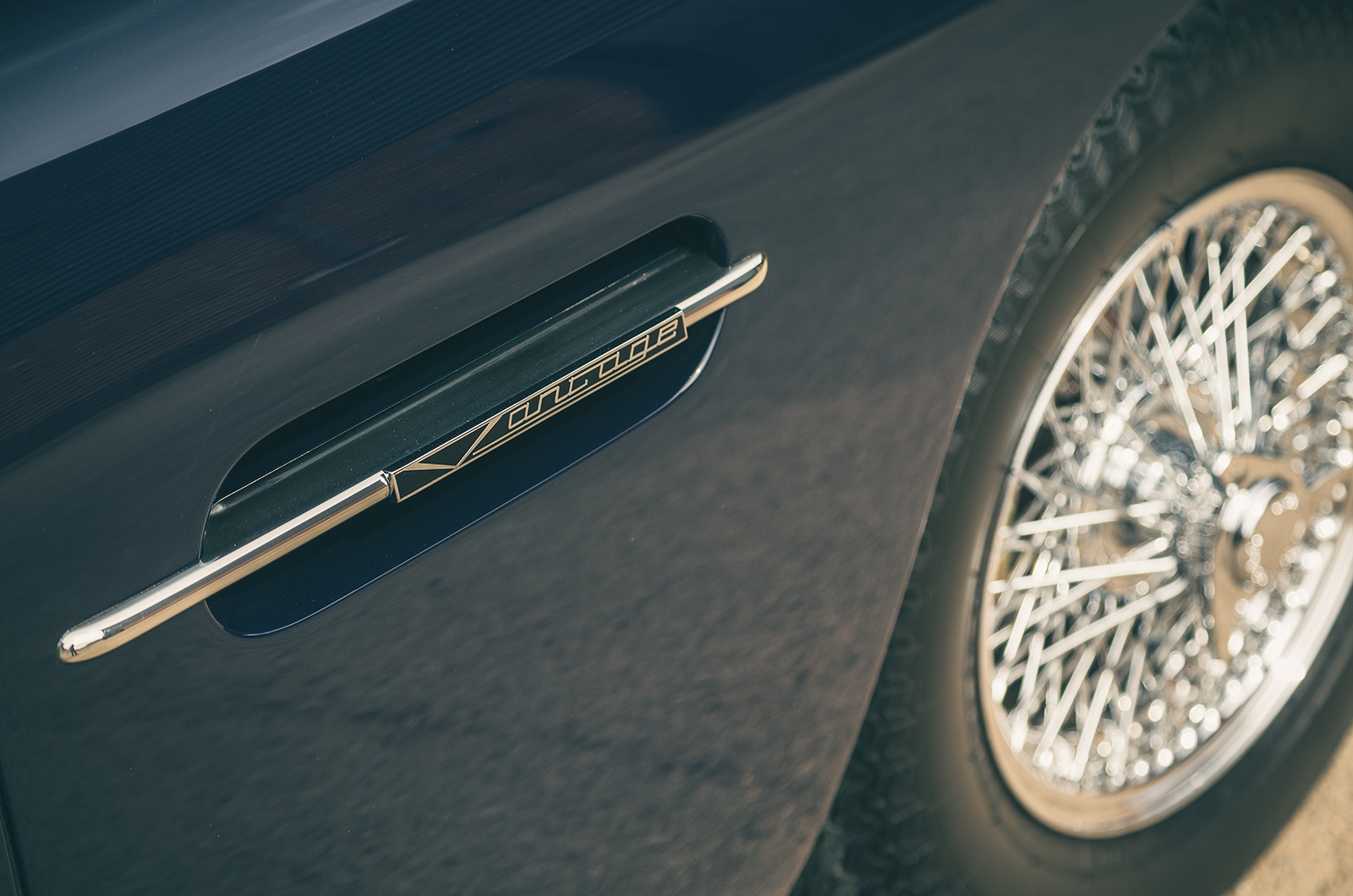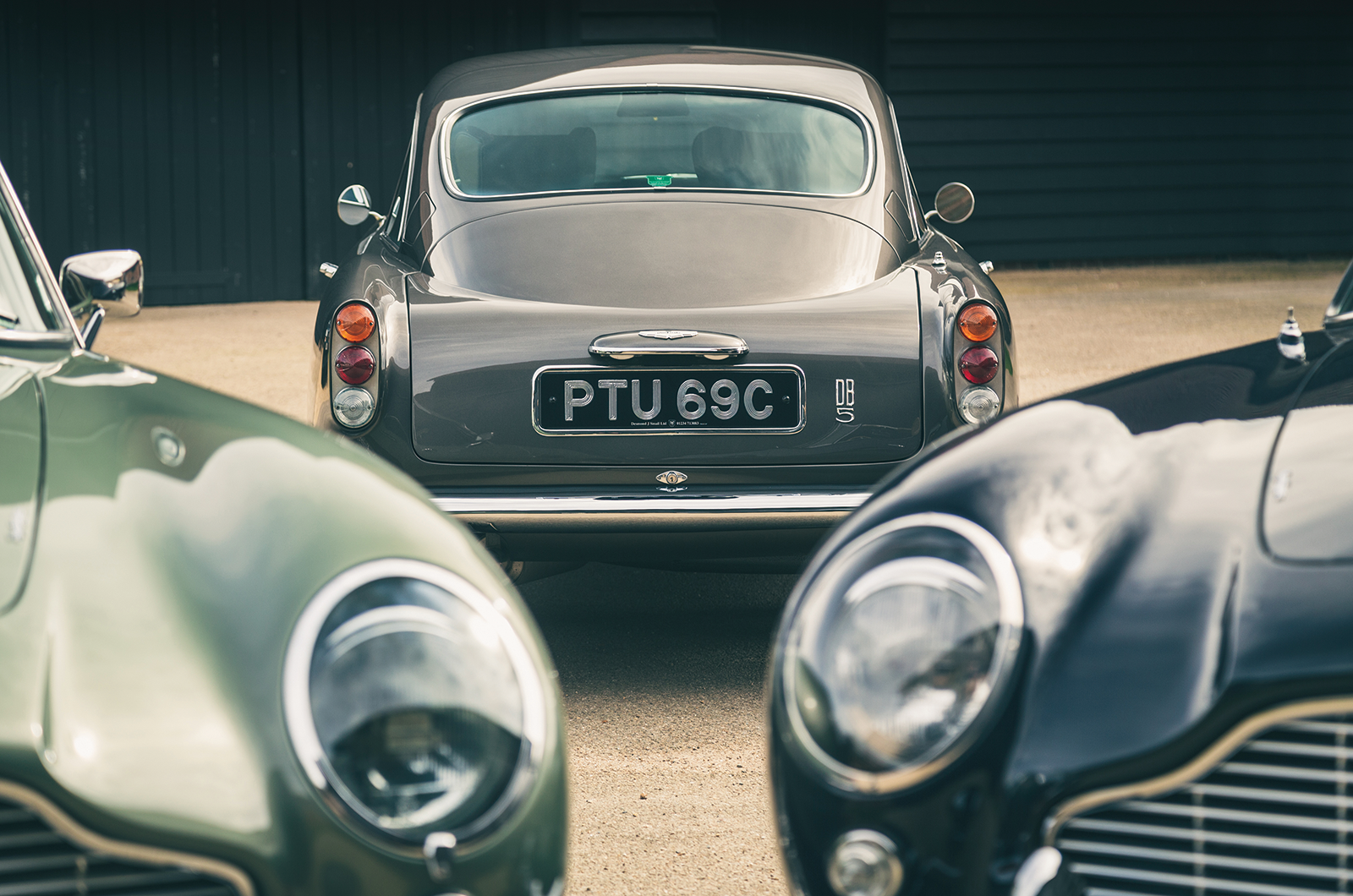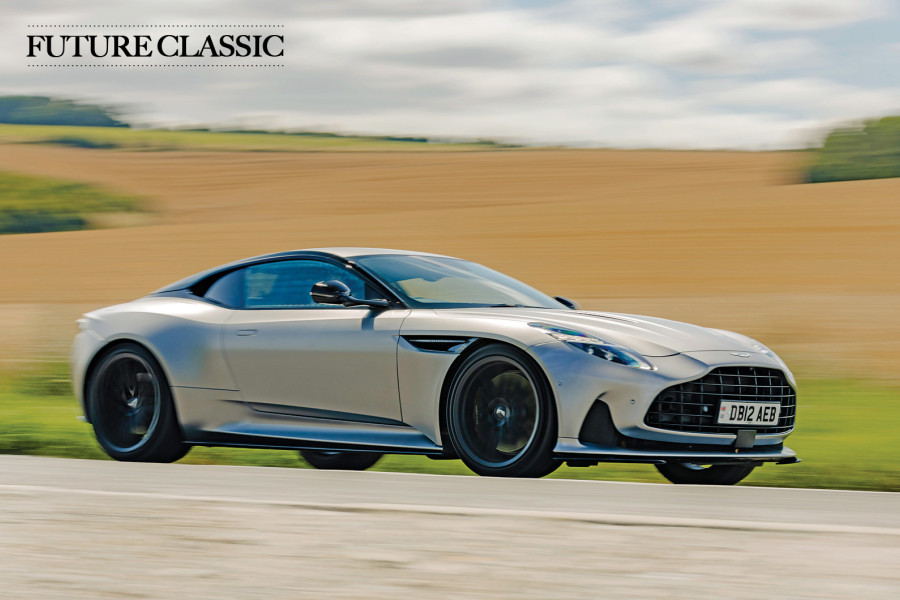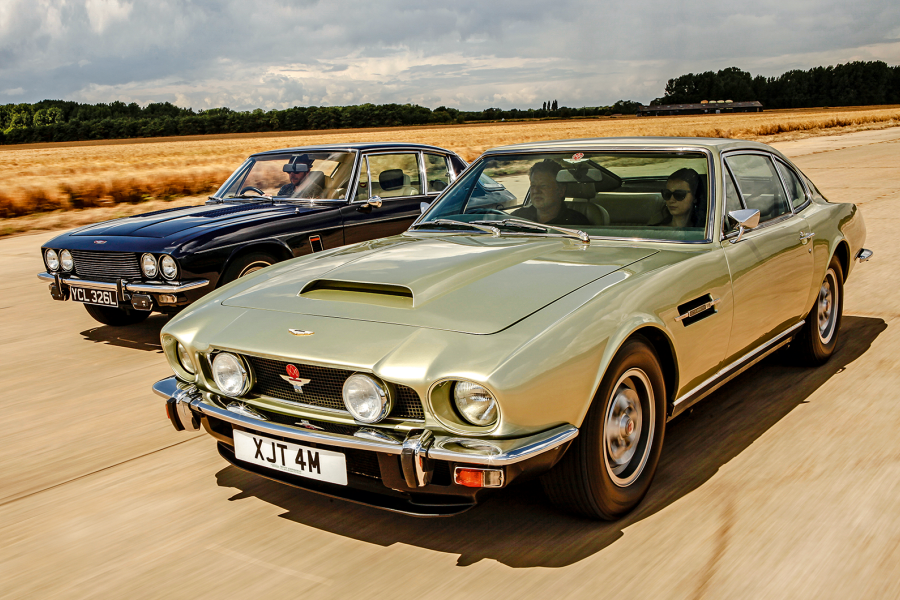Delivered new to its first Midlands owner in Dubonnet Rosso, the Cumberland Grey 1965 saloon is one of 670 right-hooker fixed-head DB5s.
It was restored almost 20 years ago, complete with then-modern air conditioning, but still runs a matching-numbers, triple-SU (non-Vantage) 4-litre engine.
One of 81 right-hand-drive DB5 Convertibles produced, this Pacific Blue, three-owner drophead was also delivered new in 1965.
Originally Caribbean Blue, it was in long-term ownership between 1973 and 2010.
The DB5 shooting brake borrows tail-lights from the short-chassis DB6 Volante
Chassis DB5C 1906R has covered just 1000 miles since a body-off, £300,000 Works restoration that included the now almost routine upgrade to 4.2 litres, plus Koni telescopic dampers all round and a Becker Mexico radio.
The California Sage Radford is the only DB5 shooting brake converted to Vantage specification in period by the factory.
Still with only 59,280 miles on the clock, its second owner, based in Kingston upon Thames, London, cherished it for almost four decades before parting company in 2011.
The inevitable six-figure restoration ensued.
The longer roof sacrifices some rigidity
Logic-defying price-tags attached to what are, in essence, traditionally conceived (if still beautifully built) six-cylinder sports cars tend to bring out the cynic in those of us who cannot afford such things…
Or nostalgia among those old enough to remember a time in the early 1970s when you could have bought quite a good DB5 for a shade less than £1000 (see below).
Yet there is a magic to these cars – both at rest and when under way – that transcends the telephone-number prices and the James Bond factor.
The beautiful yet brawny shapes are elegant and self-confident, while there’s also the sensuality of well-groomed materials: 672lb of hand-beaten light alloy, and three and a half cowhides, went into each DB5.
Unsurprisingly, the Radford is the roomiest DB5 inside
The doors are long and open wide to reveal generously dimensioned front seats with headrests that look slightly out of place.
The saloon is trimmed in black, the Convertible, with its neatly stowed hood and narrower rear seat, in Magnolia.
With its Crimson leather and carpets, chromed tailgate springs and neatly boxed-in hinges, every detail of the shooting brake is in keeping with its Aston identity.
Making those long, elegant rear side windows entailed moving the fuel fillers into the wings, as in the Convertible.
The one-piece rear lights are shared with short-chassis DB6 Volantes.
The Aston Martin DB5’s dashboard is filled with seven dials, but manages to avoid looking cluttered
Inherited from the DB4, all versions have the same dash of smart, shiny, chrome-rimmed instruments (seven in all, plus a central clock) in a handsome, no-nonsense binnacle with clearly marked knobs that variously twist or pull, depending on function.
The speedy, super-smooth electric-window mechanisms were another in-house Aston design, contrived so that they slowed down near the top of their movement to save probing small fingers.
There is plenty of window area and the ’screen pillars are skinny enough to give modern-day safety-conscious engineers nightmares.
The big steering wheel hints at the DB5’s heavy low-speed handling
All three have commandingly sonorous acceleration – the SUs in the saloon being slightly quieter than the shooting brake’s Webers – yet will potter along like dowagers’ limousines at low speeds.
With 4.2 litres, the Convertible is decisively the lustiest of the trio.
Magnificent surging torque makes short work of any straight or overtaking opportunity, with a silken boom from the exhaust and no need for high revs or fussy gear play.
Not that changing gear is a chore, particularly the closely stacked top three ratios, in any of these ZF-equipped DB5s.
The Radford’s vast hatch opens to folding rear seats
Amid rising metallic thunder the tail squats, the nose lifts and you are soon doing nearly 50 in a high first gear – tall enough that you have to be quite decisive with the clutch (which isn’t heavy) to get away smoothly, balancing slightly more revs than you might expect against a well-defined biting point.
The ratios are ideally spaced, with a nifty feel to the lever action on the upper three.
Changing down into second, it feels natural to heel-and-toe the floor-hinged pedals.
Smoothly potent, well-balanced disc brakes live up to the original hype.
The neat rear quarterlights of the DB5 shooting brake
The generous span of the wood-rimmed steering wheel hints at the leverage needed to manoeuvre at low speeds between beggarly locks, but this seems a fair trade-off against the DB5’s accuracy and reassuring stability at higher speeds.
When swooping through long, fast curves in particular, the near-equal front-to-rear weight distribution makes the handling feel delightfully neutral.
On slower, tighter turns, the helm loads up just enough to be reassuring, yet there is always sufficient urge in hand to make the cornering a function of throttle position as much as steering.
Powering through is the preferred and neater way to negotiate a corner in any of these energetic sporting GTs.
In Vantage spec, the straight-six engine offers 325bhp
The live rear axle is mightily braced against braking, torque and twisting loads, yet has enough articulation to give a firm but acceptable ride.
So, when the balance of weight is transferred, the back wheels dig in to put the power down with a lack of fuss that was probably unique among high-powered, non-IRS-equipped GT cars.
With such lusty, faithful urgency of response – deemed ‘vintage’ even when the cars were young – for the driver, the DB5 is a machine that only gives back what you put in.
It is imbued with an aura of uncompromising masculinity that won’t suit everyone.
Today, the one-of-12 shooting brake still commands a premium over other DB5s
The DB4 was arguably prettier and ‘purer’ in concept; the improved, longer-wheelbase DB6 was, logically, the better, more sorted car, even if its chopped-tail styling received mixed reviews.
Yet it is the now 60-year-old DB5 that still casts the longest shadow of all the six-cylinder, Touring of Milan-styled Astons.
A timeless pin-up of Britain’s most revered sporting marque, its sacred-cow status goes far beyond the 007 effect.
Less fragile than the DB4, yet too lean and graceful to be a muscle car cast in the mould of its rumbling V8 successors, the DB5 was simply the sweet spot in the firm’s quest to build the best-possible, six-cylinder all-round grand touring car.
Images: Luc Lacey
Thanks to: Nicholas Mee & Co
The Aston Martin DB5’s journey from rags to riches
Aston Martin DB5 values have fluctuated throughout the model’s 60-year history
At £4248 in 1963, a DB5 saloon cost the equivalent of £115,000 in today’s money.
Given that most DB5s are now worth well north of £500k, the owner who had the space, money and foresight not to part with said vehicle would be feeling pretty smug.
A DB5 was by no means the most expensive car listed in the UK in 1963; that accolade belonged to the Rolls-Royce Phantom V with James Young Touring Limousine body, at £9286, soon to be eclipsed by the £11,000 Ferrari 500 Superfast.
But the DB5 was more expensive than almost all of its local GT rivals, and the Purchase Tax alone on the car would have bought nearly two BMC Minis.
This at a time when the average wage of a non-manual worker was £1200, and most houses cost well under £3000.
By the end of the decade, the picture had changed somewhat.
In one of its 1968 used-car tests, Autocar reported on a 1964 DB5 that could have been bought from a dealer for £1895, which meant depreciation of about £600 a year, at the most favourable interpretation.
‘It is the 60-year-old DB5 that casts the longest shadow of all the six-cylinder, Touring of Milan-styled Aston Martins’
To give some perspective, there was a wide choice of new cars still available for £1895 in 1968, including the last of the 3.8-litre S-type Jaguars or a Citroën DS21 Pallas.
Autocar’s DB5 came with a £700 invoice for a new engine, too – enough to buy a factory-fresh Ford Cortina – and the writer was horrified to learn that a 10,000-mile service was £94: probably twice what he was earning a week.
The fact that Newport Pagnell had recently slashed DB6 prices to clear stocks (to almost exactly the 1963 price of the DB5) probably didn’t help the used Aston trade.
Prices held steady at £1500 through the early ’70s, but privately they could be had for sub-£1000, or about the price of a basic Ford Escort.
When C&SC launched in 1982, DB5s were running at between £5000 and £6000, or not much more than an S1 Bentley or a Gordon-Keeble, and quite a lot less than a really nice MG TF. Work that one out.
Factfile
Aston Martin DB5
- Sold/number built 1963-’65/1059
- Construction steel platform chassis, aluminium body over tubular steel frame
- Engine all-alloy, dohc 3995cc straight-six, with triple SU carburettors (Webers on Vantage models)
- Max power 282bhp @ 5500rpm
- Max torque 280Ib ft @ 4500rpm
- Transmission five-speed manual, RWD
- Suspension: front independent, by double wishbones, telescopic dampers, anti-roll bar rear live axle, four trailing arms, Watt linkage, adjustable lever-arm dampers; coil springs f/r
- Steering rack and pinion
- Brakes discs, with servo
- Length 15ft (4570mm)
- Width 5ft 6in (1676mm)
- Height 4ft 5in (1346mm)
- Wheelbase 8ft 2in (2489mm)
- Weight 3236Ib (1468kg)
- Mpg 17
- 0-60mph 8.1 secs
- Top speed 142mph
- Price new £4084
- Price now £600,000-1m+*
*Price correct at date of original publication
Enjoy more of the world’s best classic car content every month when you subscribe to C&SC – get our latest deals here
READ MORE
Aston Martin DB5 vs Mercedes-Benz 300SL vs Ferrari 275GTB: million dollar babies
20 oddball Aston Martins
Better by the dozen: Lamborghini Murciélago vs Aston Martin Vanquish S vs Ferrari 575M
Martin Buckley
Senior Contributor, Classic & Sports Car
